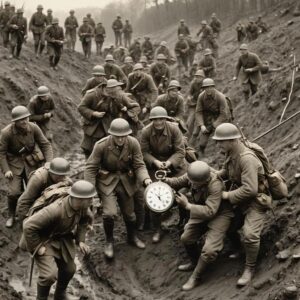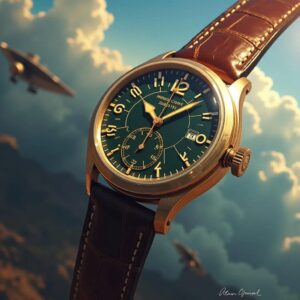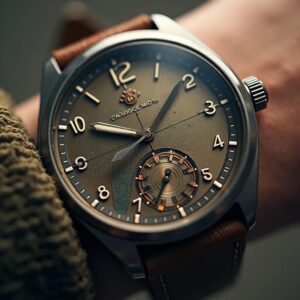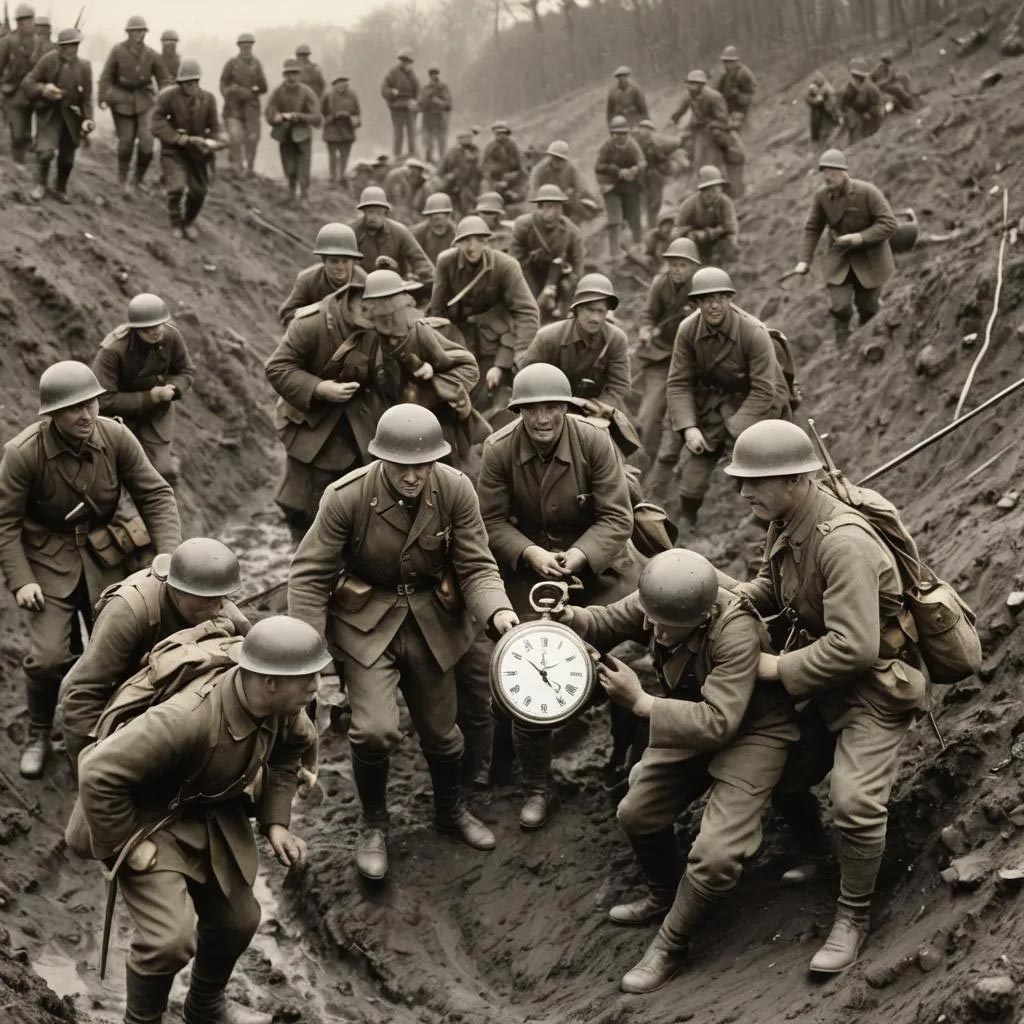As the summer of 1914 drew to a close, soldiers across Europe nervously adjusted their newly acquired wristwatches. Little did they know that these small devices strapped to their wrists would not only change their lives but also revolutionize the way the world kept time. The Great War was about to unfold, and with it, a transformation in timekeeping that would echo through the decades to come.
The Eve of War: Pocket Watches Reign Supreme
In the days leading up to World War I, the pocket watch was the epitome of timekeeping elegance. Men of status proudly carried these ornate timepieces, nestled safely in waistcoat pockets. Wristwatches, on the other hand, were considered a woman’s accessory, delicate and impractical for the rough-and-tumble world of men.
Interestingly, some forward-thinking individuals had already recognized the potential of wristwatches in military applications. During the Boer War (1899-1902), some British officers had begun to strap their pocket watches to their wrists for easier access during battle. However, these were exceptions rather than the rule.

The Trenches: Where Time Became Life or Death
As the conflict erupted and soldiers found themselves in the muddy trenches of the Western Front, the inadequacies of pocket watches quickly became apparent. Coordinating attacks, timing artillery barrages, and even knowing when to duck from enemy fire all depended on split-second timing. Those fumbling with pocket watches while holding rifles soon envied their comrades’ ability to tell time at a glance.

Stories began to circulate of wristwatches saving lives. In one account, a soldier’s watch deflected a sniper’s bullet, shattering the crystal but sparing his wrist. Another tale told of a coordinated attack that succeeded only because of the precise synchronization allowed by wristwatches. Such stories spread rapidly through the ranks, and soon more soldiers began modifying their own pocket watches, attaching leather straps to wear them on their wrists.
The Watch Industry Responds: Birth of the “Trench Watch”
Watchmakers were quick to recognize the opportunity presented by the war. Companies like Omega, Cartier, and Rolex began producing watches specifically designed for military use. These “trench watches” featured several innovations:
- Luminous dials painted with radium for nighttime readability
- Protective grilles or “shrapnel guards” over the face to prevent damage
- Unbreakable glass to withstand the rigors of trench warfare
- Waterproof cases to protect against the damp conditions in the trenches
One particularly noteworthy development was the “wire lug” watch, which featured thin wire lugs soldered onto pocket watch cases, allowing them to be worn on the wrist. This improvised solution bridged the gap between pocket watches and purpose-built wristwatches.
The Military Embraces the Wristwatch
As the war progressed, military authorities began to recognize the tactical advantages of wristwatches. The British War Department started issuing wristwatches to soldiers, and by 1917, it was estimated that over half of the soldiers wore them.
A famous anecdote from this time tells of a British general who, upon being presented with a new shipment of pocket watches for his men, immediately ordered them to be converted to wristwatches. When questioned about this decision, he reportedly said, “The wristwatch is as essential as the rifle in modern warfare.”
From Battlefield to Fashion Statement
As the war drew to a close in 1918, soldiers returned home, their wristwatches a badge of honor and a reminder of their service. The public, who had spent years reading about the heroic exploits of these soldiers, began to view wristwatches in a new light. No longer were they seen as feminine accessories, but as practical tools worn by brave men.
Civilians, inspired by the image of the returning soldiers, began adopting wristwatches en masse. A curious anecdote emerged from this time: A popular London newspaper ran an advertisement declaring, “The man who doesn’t wear a wristwatch is hopelessly behind the times.” The pocket watch industry, sensing its impending doom, launched a campaign claiming that “real men” still used pocket watches. Their efforts were in vain; the wristwatch had captured the public’s imagination.
The Roaring Twenties: When Time Became Fashionable
As the 1920s dawned, wristwatch design exploded with creativity. The utilitarian trench watches evolved into stylish accessories, with Art Deco designs and precious materials becoming increasingly common. Watchmakers competed to create the most elegant and innovative timepieces, pushing the boundaries of both technology and fashion.
This period saw several groundbreaking innovations in wristwatch technology:
- In 1923, John Harwood invented the first self-winding wristwatch mechanism
- In 1926, Rolex introduced the “Oyster” case, the first truly waterproof wristwatch
- In 1927, Bulova introduced the first electric watch, powered by a tiny battery
The Rolex Oyster deserves special mention, as it represented a significant leap forward in watch technology. Inspired by the sealed cases of submarine hatches during the war, the Oyster case was completely waterproof. To demonstrate its capabilities, Rolex famously had a young English swimmer, Mercedes Gleitze, wear one during her attempt to swim the English Channel. After more than 10 hours in the cold water, the watch emerged in perfect working order.
Wristwatches in Aviation and Exploration
The interwar years saw wristwatches become essential tools in the fields of aviation and exploration. Pilots, in particular, found wristwatches indispensable for navigation and timing. In 1927, Charles Lindbergh wore a wristwatch during his historic solo flight across the Atlantic, cementing the association between wristwatches and adventure.

Watchmakers began developing specialized watches for aviators, featuring additional complications like chronographs and slide rules. The Longines Hour Angle watch, designed in collaboration with Charles Lindbergh himself, allowed pilots to calculate their longitude during flights.
World War II: The Wristwatch Proves Its Worth Again
When World War II broke out in 1939, the wristwatch was already an established military tool. However, the conflict drove further innovations in watch design and manufacturing. Military-issued watches became even more specialized, with features like:
- Hacking seconds (the ability to stop the second hand for precise synchronization)
- Anti-magnetic cases to protect against electromagnetic fields in vehicles and aircraft
- Black dials and cases for nighttime operations
The famous “Dirty Dozen” watches, commissioned by the British Ministry of Defence and produced by 12 different Swiss manufacturers, became legendary among watch enthusiasts and collectors.
The Post-War Era: Wristwatches for Everyone
After World War II, wristwatch production and technology continued to advance rapidly. The 1950s and 60s saw the introduction of automatic movements, electric watches, and eventually, quartz movements. The Swiss watch industry, which had dominated mechanical watchmaking, faced significant challenges from these new technologies, particularly from Japanese manufacturers like Seiko.
Despite these challenges, mechanical wristwatches retained their appeal, evolving into luxury items and status symbols. The legacy of those early trench watches lived on in the rugged design of tool watches and dive watches, which became popular in the post-war decades.
The Legacy of War Time
As we reflect on the history of the wristwatch, it’s clear that World War I played a pivotal role in its evolution from a niche accessory to an essential everyday item. The conflict’s unique demands led to technological improvements and a shift in public perception, paving the way for the wristwatch to become the dominant form of portable timekeeping in the 20th century and beyond.
The development of wristwatches during World War I led to significant advancements in precision timekeeping. The need for accurate synchronization in warfare pushed watchmakers to improve their mechanisms, eventually leading to the development of the quartz watch movement in the 1960s, which revolutionized timekeeping once again.
Today, as we check our wrists, whether glancing at a smartwatch or admiring a vintage timepiece, we owe a debt to those soldiers in the trenches of World War I. They transformed a humble tool into an enduring symbol of human ingenuity and resilience, forever changing how we interact with time itself.

The story of the wristwatch serves as a fascinating example of how global events can have unexpected and lasting impacts on everyday life. From the muddy trenches of the Western Front to the wrists of millions around the world, the journey of the wristwatch is a testament to human adaptability and the enduring importance of keeping time in our fast-paced world.

